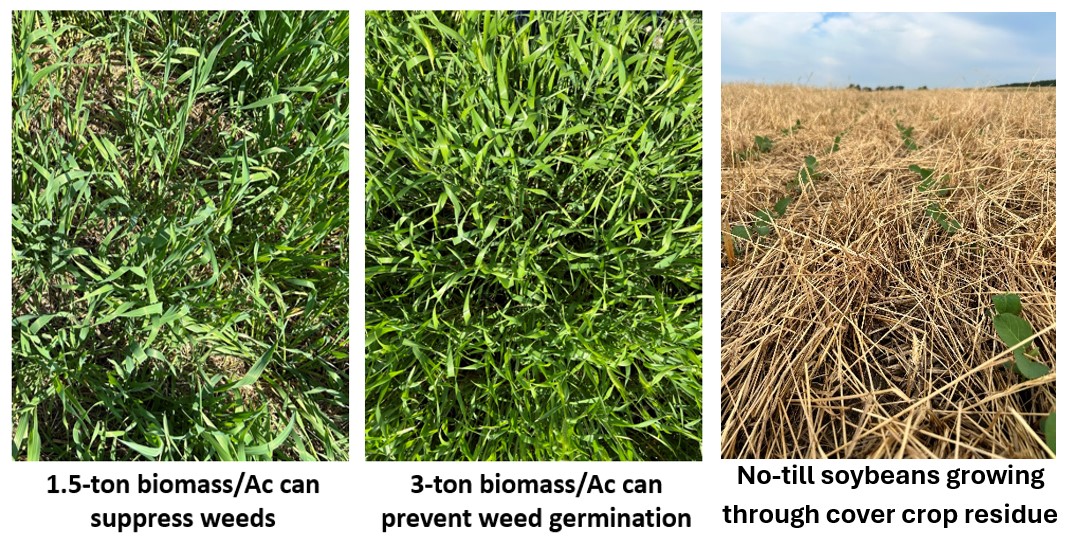Want to know how your cover crop is performing? It’s all about the biomass.
Check out the new interactive map from the Great Lakes Cover Crop project showing variation in cover crop biomass across the region.

Do you know how your cover crop is performing? Cover crops can bring a long list of benefits to your fields including:
- Suppressing weeds
- Preventing erosion
- Nitrogen provisioning
- Breaking up compaction
- Building soil
- Attracting beneficial insects
The benefits gained from cover crops are dependent on the type of cover crop and the quantity of cover crop growth, or biomass, that is produced before termination. A summary from Purdue University of studies from across the Midwest show that 1.5 tons of aboveground cereal rye biomass/Ac can suppress and slow down weed development. If you have more than 3 tons of cereal rye, the thick layer of residue can prevent various weeds from germinating entirely. Wisconsin researchers found 1.5 ton cereal rye/Ac suppressed giant ragweed by 50% and >2.3 ton cereal rye biomass/Ac suppressed water hemp by 50% without use of a preemergent or post emergent herbicides. Cereal rye and other grass cover crops provide stronger weed suppression than most broadleaf cover crops because the residue tends to decompose slower. Residue that lasts longer on the surface can continue to provide weed suppression throughout the growing season.

Erosion control depends both on the aboveground (leaves and stems) and belowground (roots) growth. The aboveground biomass can slow the movement of water across the surface and protect soil from the impact of rain that can break up soil aggregates, making soil particles susceptible to surface runoff. Belowground biomass promotes water infiltration, which reduces the volume of water running off fields.
If you are counting on taking a nitrogen credit from your legume cover crop, the more biomass the merrier. For example, if you have a clover cover crop that is 2% nitrogen (N) by weight, then you need 1-ton dry weight biomass/Ac to be able to count on 40 lbs. of plant available nitrogen per acre. In typical row crop systems in Michigan, it can be difficult to find a growing period for legume cover crops to develop long enough that they produce a reliable supply of N. In most cases, seeding after corn or soybean harvest and terminating before planting soybean or corn the following spring does not allow enough time, so farmers should not depend on taking an N credit in the next year. One case where a legume cover crop may produce enough N to take an N credit in your following cash crop is when clover is frost-seeded into wheat. Check out the MSU Extension Bulletin E2185 ‘Frost Seeding- an Effective Establishment Practice for Michigan’ for information on how to frost seed clover into winter wheat.
Interested in figuring out how your cover crop is performing?
The best time to measure would be just ahead of termination, whether that is ahead of frost, herbicide application or tillage. It is easiest to measure aboveground dry matter biomass. Measuring roots can be tedious and messy. The Oregon State University bulletin "Estimating plant-available nitrogen release from cover crops" has detailed instructions for how to collect cover crop biomass samples to estimate total aboveground biomass.
Want to know how your cover crops compare to cover crops across the Great Lakes region?

The Great Lakes Cover Crop project, started in 2021, publishes cover crop biomass estimates from across the Great Lakes regions. Participants submit photos and height measurements of their overwintering cover crops just ahead of termination. The project has attracted a network of over 100 farmer cooperators. The data so far reinforces that management makes a big impact on biomass. With sufficient rainfall and temperature, cover crops seeded early and terminated late produce more biomass. The data also suggests that mixes tend to outperform single species cover crops. You can explore the data now on an interactive map.
For information about how to manage high-performance cover crops, check out the MSU Extension Cover Crop Teams Resources and the Midwest Cover Crop Councils website.



 Print
Print Email
Email




